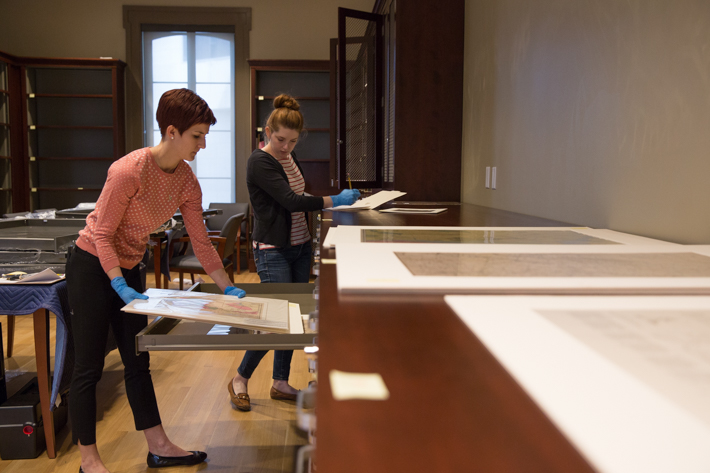Inside the Albert H. Small Center for National Capital Area Studies, located in the historic Woodhull House, Anne Dobberteen, M.A. ’12, sorts through the contents of a massive steel drawer. The compendium is filled with more than two centuries of D.C. history: A thin clipping from a newspaper called the National Intelligencer tells us the headlines of the day on Nov. 14, 1800, while a tollbooth ticket from 1833 reveals that it could cost anywhere from 1 to 20 cents to cross a road between Leesburg, Va., and Washington.
These objects all show the evolution of the nation’s capital. They are each part of the Washingtoniana Collection, which Albert H. Small donated to the university in 2011 to form a new museum on campus—now the jointly cobranded George Washington University Museum and The Textile Museum. Mr. Small also provided $5 million to restore the museum’s adjacent Woodhull House and make it the permanent showplace for his trove of historical treasures.
The collection—made up of 1,000 maps, prints and other Washington momentos—had been stored in Mr. Small’s office and home until it was brought it to Foggy Bottom last month. Ms. Dobberteen, the collection’s assistant curator, is leading the process of moving the objects into their new home in time for the museum’s opening March 21. Most of the materials will be placed in the Albert H. Small Center for National Capital Area Studies, located on the ground floor of the Woodhull House.
Getting all the materials out of their carefully wrapped boxes is a massive task, so Ms. Dobberteen asked GW students for help.
Unpacking historic material in a museum setting instantly appealed to senior Andrea Marshall, a history minor who recently was accepted into GW’s museum studies master’s program
“I jumped on it. I was like, ‘Unpack artifacts? That sounds great,’ ” Ms. Marshall said.
“It’s a good opportunity for any undergrad,” Ms. Dobberteen chimed in. “I didn’t get to work with collections until I was a grad student.”

“Researchers will be able to come in and look at everything firsthand,” Ms. Dobberteen said, gesturing toward several tables and chairs in the room where the study of objects will take place.
She’s done an extensive amount of research on the collection. After getting her master’s in American studies at GW, Ms. Dobberteen helped inform a catalog written by the Washingtoniana Collection’s longtime curator James M. Goode, PhD ’95. Now, as assistant curator, she knows the collection inside and out, from its oldest item (a map of Maryland from the late 1600s) to its oddest souvenir (16 miniature prints of major government buildings that fold into a small box like an accordion).

Maggie Leak, M.A. ’14, another one of Ms. Dobberteen’s volunteers, explained that the collection offers Washingtonians new ways of looking at their home. It’s something she learned while doing graduate research on a hand-drawn map from the 18th century.
“I came to D.C with relatively little knowledge of the history of our nation’s capital,” Ms. Leak said. “My research added so much depth to my experience in this city.”
When the objects are unpacked by the end of this week, it will mark a new era for the Washingtoniana Collection—and it’s something Ms. Dobberteen looks forward to after months of planning and careful preparation.
“I’m thrilled that students, faculty and researchers will be able to utilize the wonderful resources available here for years to come,” she said.


